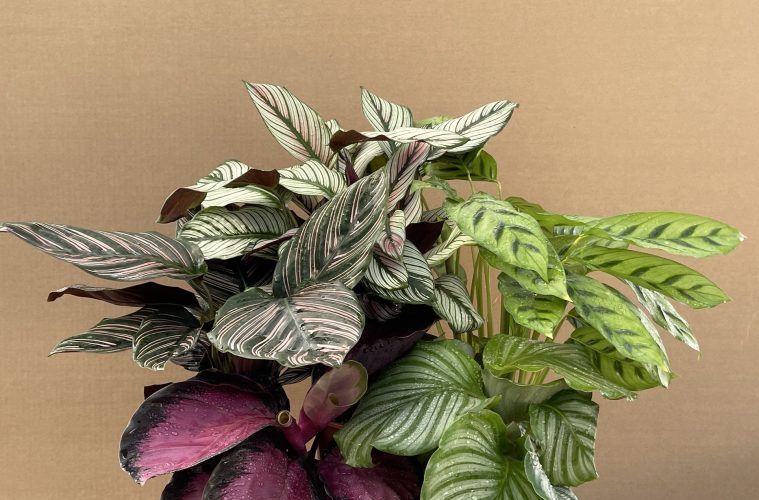Calatheas are the new houseplant must-have. With so many stunning varieties, its not hard to see why.
Calathea orbifolia
Calathea orbifolia is the most popular variety at the moment, and maintains its reigning title of most Instagrammable houseplant. There is a simple elegance to the green and silver-striped leaves hard to find in any other indoor plant. The specific epithet ‘orbifolia’ refers to the orbicular or rounded leaves of this species. This beautiful plant hails from Bolivia and although it is extremely popular amongst indoor plant collectors, it is not the easiest of the prayer plants to grow. Lots of indirect light is needed – any direct sunlight could burn the leaves or ‘bleach’ them, resulting in an undesirable pale colour. They also need frequent watering, preferring soil that is moist but not wet. Move the plant around in your home until you find the spot with the correct light intensity. These plants prefer warm conditions and should not be subjected to temperatures below 15 degrees Celsius. Good air movement is vital, as with most indoor plants, but avoid cold draughts from open windows or air conditioners. The higher the humidity, the better this plant will grow.
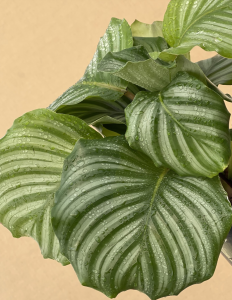
Calathea leopardina
One of the easier species to grow is Calathea leopardina, originating from Brazil. The leaves are lime green with dark green markings, vaguely resembling leopard print. This plant requires the same watering and light requirements as Calathea orbifolia, but this variety can handle slightly lower minimum temperatures at 12 degrees Celsius.
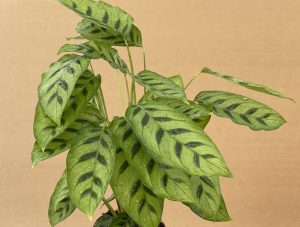
Calathea sanderiana ‘Ornata’
Calathea sanderiana ‘Ornata’ is known as the pinstripe Calathea. The dark maroon-purple foliage is decorated with cream and light pink stripes which look almost hand painted. Growing conditions for this variety are similar to those of Calathea orbifolia, although they can be a bit more forgiving and usually fare better indoors.
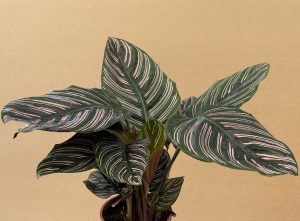
Calathea majestica ‘White Star’
The specific epiphet of this species is quite descriptive as it truly is majestic. This is a showy species, growing much taller than Calathea orbifolia or Calathea sanderiana and making a statement indoors.
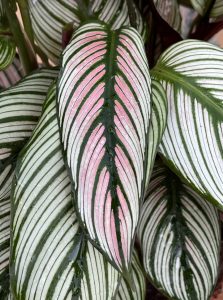
Calathea picturata ‘Crimson’
Calathea picturata ‘Crimson’ is one of the newer varieties on the scene, not as well-known to collectors yet. It is, however, truly beautiful with vivid magenta leaves edged in dark maroon. This species is also one of the first to show cold damage – dried patches on the leaves indicate exposure to low temperatures.
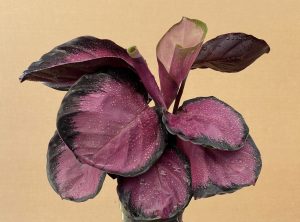
Care Tips
Calatheas are fairly heavy feeders and will benefit from a weekly dose of diluted water-soluble fertiliser. Plants with a yellow appearance that are not actively growing usually indicate a shortage of nutrients. Cleaning the leaves on a regular basis will not only keep the plants looking their best, but will also remove dust and other particles which can hamper gas exchange. Placing the plant outside in the rain or under the shower is an easy way to clean the leaves. Avoid using aerosol cleaners as this can cause damage.
ALSO SEE CARE TIPS FOR HOUSE PLANTS

